The Influence of Plant Development Stage and N Fertilization on the Content of Water-Soluble Carbohydrates and Fructans in Different Varieties of <em>Lolium perenne</em>
DOI:
https://doi.org/10.5073/JfK.2009.10.01Keywords:
Perennial ryegrass, Lolium perenne, high sugar grass (HSG) variety, N fertilization, water soluble carbohydrates (WSC), fructans, polymerization level (DP), anionic exchange HPLC with pulsed amperometric detectionAbstract
Efficient ruminant nutrition requires the simultaneous availability of nitrogen and metabolic energy from quickly fermenting water-soluble carbohydrates (WSC). To find higher WSC contents in perennial rye grass (Lolium perenne), the WSC level in the course of plant development and under the influence of diurnal rhythm and N fertilization intensity was studied. For this purpose, five varieties were analysed for two years under two N fertilization steps and harvested on four (2006) or rather eleven dates (2007) during the first growth period. The WSC and fructan content were analysed with HPLC and the polymerisation level of fructans with anionic exchange HPLC with pulsed amperometric detection.
The varieties achieved an average WSC and fructan content of 22.4% and 13.6% respectively of the dry matter. The highest levels were reached with the High Sugar Grass (HSG) variety Aberavon. In the course of plant development, the highest WSC and fructan contents were observed at the beginning of ear emergence, with higher contents in the stalks than in the leaves. In contrast to the time of day, the level of nitrogen fertilizer had a significant impact on WSC content, the lower fertilization led to a 26.1% higher WSC and a 41.2% higher fructan content compared to the control. With increasing plant development, the relative portion of fructans with low polymerization level (DP) dropped, while that with higher DP increased. The HSG variety Aberavon was also marked by a higher portion of short chain and a lower portion of long chain fructan polymers. The energy content and the digestibility of perennial ryegrass can apparently be influenced positively by a combination of choice of variety, optimal plant development stage and moderate N fertilization.
Downloads
Published
Issue
Section
License
The content of the journal is licensed under the Creative Commons Attribution 4.0 License. Any user is free to share and adapt (remix, transform, build upon) the content as long as the original publication is attributed (authors, title, year, journal, issue, pages).
The copyright of the published work remains with the authors. The authors grant the Journal of Cultivated Plants, the Julius Kühn-Institut and the OpenAgrar repository the non-exclusive right to distribute and exploit the work.







